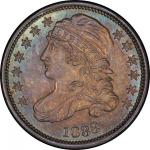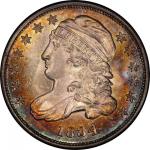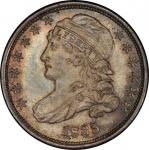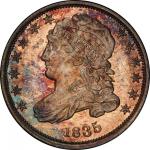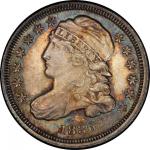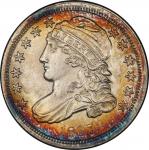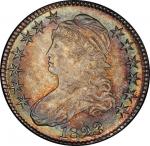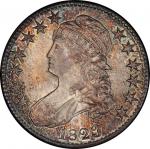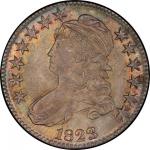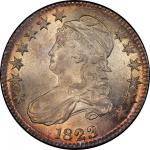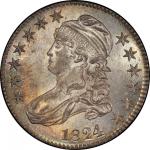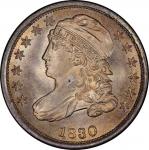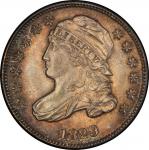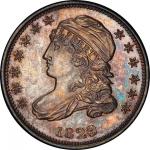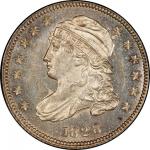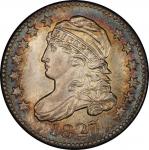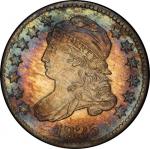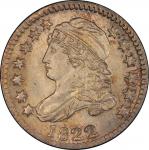“Proof sets, properly so called, cannot be unequivocally documented prior to 1834 ... Nevertheless, complete sets could have been made in most years from 1820 on.” — Walter Breen, Walter Breen’s Encyclopedia of United States and Colonial Proof Coins, 1977 Early Proofs such as this exist at the intersection of history, rarity, and beauty. With its famous provenance, infinitesimal population, and profound visual appeal, this piece’s desirability ranks high. The surfaces are deeply reflective, toned violet-rose, sea green, bright yellow, and coppery-gold. The devices show the sort of strike associated with later Proof strikings, complete from center to rim. The dies are fresh and uncracked, though an area of raised frost beneath the wing left of the eagle suggests a light clash mark removed before the JR-6 marriage. The obverse is new in this usage, and the tiny crack that joins the top of the 3 to the bottom of the 3 probably emerged before a single coin was struck. This reverse was previously used on 1830 JR-5, but it survived that marriage relatively unscathed. The surfaces of this piece are likewise mostly unscathed, with a nearly invisible hairline above TE of UNITED, a tiny natural depression below star 1, and only trivial hairlines that barely require mention. David Akers knew of just three specimens of this variety in Proof: the Pittman coin, earlier from Mehl’s 1948 Allenburger auction; the James A. Stack coin, sold in Stack’s January 1990 sale; and the Eliasberg coin, the piece presently offered. Breen’s list, composed from memory after his Proof notes were lost, recalled a specimen in the Byron Reed Collection in Omaha; none was sold in the October 1996 Reed sale, so this coin is either still impounded or Breen was recalling the coin that turned out to be a prooflike Mint State JR-4. Breen’s second provenance chain strung together the Parmelee coin (unplated), the F.C.C. Boyd coin (unplated), and the Will W. Neil coin (unplated) into a single neat lineage that may or may not be accurate. His numbers 3 through 5 were no better proven, and each appearance was offered with the caveat “possibly same as last.” Preferring Akers’ memory to Breen’s, and recognizing that Akers was able to see all three coins within a single decade, his list seems the most persuasive. The PCGS population of all 1830 dimes in Proof stands at three pieces: a Proof-63 that has not sold since 2000, the Proof-65 Pittman coin, and this piece, graded Proof-65 CAM. The James A. Stack coin does not seem to have reappeared or been certified as Proof, which could mean that it’s been secreted away in a cabinet or that recent examination has failed to confirm its Proof status. Missing from the 1914 ANS Exhibition, there was no Proof 1830 dime present in most major collections of early dimes and early Proofs, including Norweb, Lovejoy, Starr, and Gardner. Breen mentions appearances of this date in Proof in both the 1890 Cleneay sale and the 1895 Winsor sale. The frequency of a Cleneay-Winsor-Earle provenance chain suggests this coin might represent all three; it is without question a match for the specimen on the fine photographic plates of the Earle catalog. Elusiveness characterizes Proofs from the early 1830s. Certainly they are rare, coined from single-digit mintages, but they are also difficult to define and lacking nearly any paper trail or record. Once diplomatic sets were introduced in 1834, there was both a reason for Proofs to exist and a standard against which specimens could be judged. Earlier pieces are shrouded in mystery. They were clearly specially made, and vigorous scholarship over decades has enabled modern numismatists to create a reasonably consistent framework of expectations, but we are unable to answer the simplest imaginable question: why was this coin made? Perhaps for a pioneering collector already active in this era, a man like Robert Gilmor, Jr. of Baltimore, who in 1841 wrote that his serious interest in collecting American coins began “many years ago?” Or for a VIP, someone like John Quincy Adams, who wrote a request as early in 1810 to receive “a specimen of every one of the coins of the Mint of the United States.” Aside from the accidental discovery of revealing documents, the true story of early Proofs may never be known. PCGS# 4549. NGC ID: 237N.




